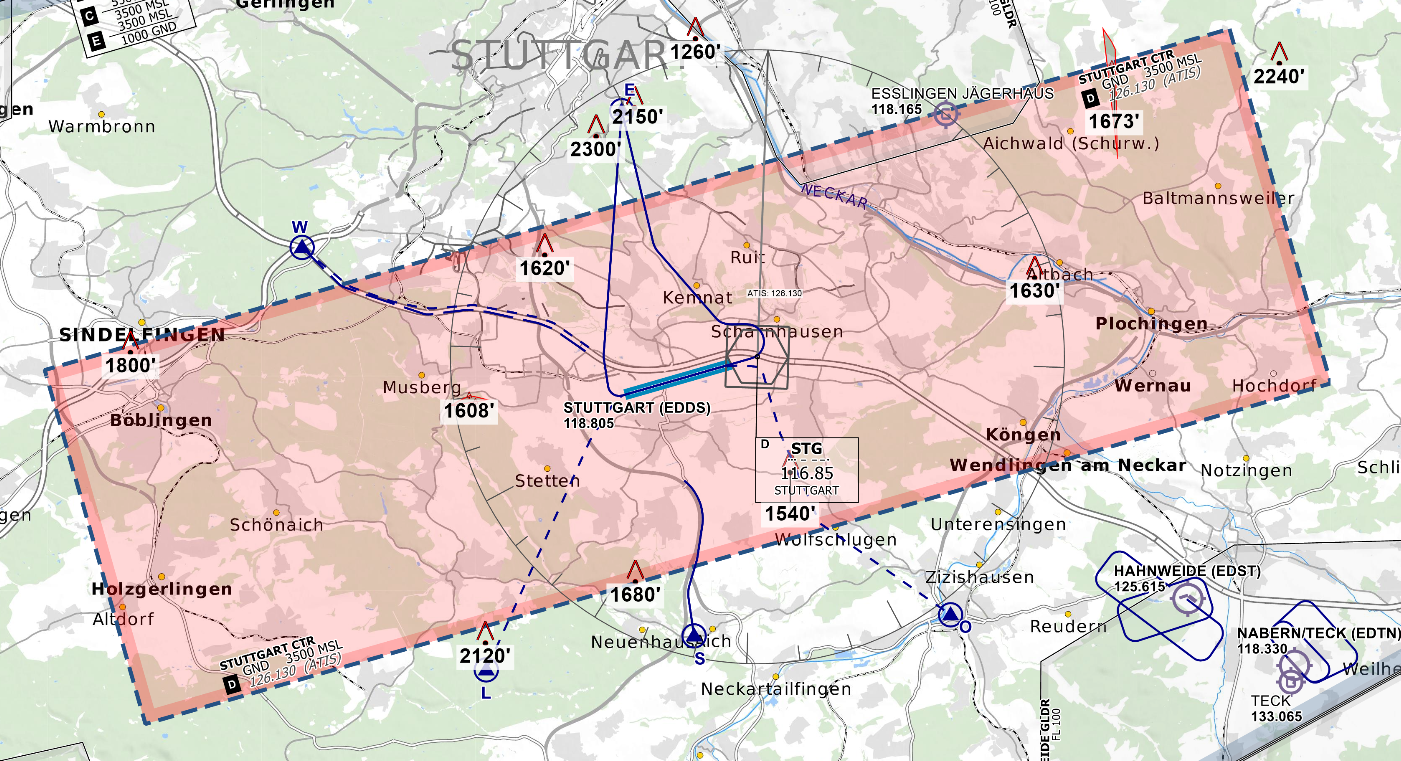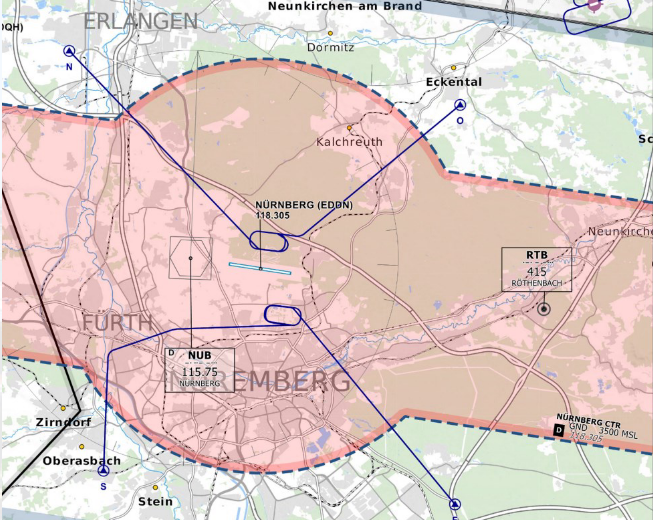VFR Basics + Entry / Exit / Crossing
Visual flight rules (VFR) traffic navigates primarily by sight, using roads, rivers and landmarks as a guide. There are specific visual flight charts for this purpose, which pilots and controllers at an airport must be familiar with. Among other things, these charts show the mandatory reporting points used to enter and leave the control zone (see illustration). Furthermore, certain routes and holding patterns may be specified, which a pilot must adhere to.
VFR approaches are not separated in relation to other traffic and are responsible for maintaining the necessary distance autonomously. To make this possible, traffic information and, if necessary, wake turbulence warnings must be used. VFR departures require wake turbulence separation.
Radio communication during VFR can take place in both German and English. Detailed radio communication procedures for VFR traffic can be found in the AIP under GEN 3.4 Fernmeldedienst if required.
Depending on the volume of traffic, it may be necessary to delay VFR flights in order to slot them between the usually faster IFR inbounds. Various delaying tactics can be used for this purpose.
 Stuttgart Control Zone (D-CTR) with comoulsory reporting points - © openflightmaps.org
Stuttgart Control Zone (D-CTR) with comoulsory reporting points - © openflightmaps.org
VFR entry & exit
For the purpose of flying in and out of the control zone, there are published entry and exit routes that lead from the airfield out of the control zone or from outside the control zone into a holding pattern that is close to the aerodrome traffic circuit.
Let's take a look at the Nuremberg airfield as an example:
You can see that Nuremberg has four published entry and exit routes for VFR. All four routes are approved for both outbound and inbound flights. There are other airfields where some routes are only approved for approach or only for departure.
At the beginning of the routes outside the control zone you will see a filled blue triangle. This symbol indicates a compulsory reporting point. This means that every pilot must report any overflight of this point with their flight altitude. If the triangle were not filled in, it would be an optional reporting point. The pilot would not report overflying this point independently, but you can ask him to. Next to the blue triangles you will see the names of the mandatory reporting points (S, E, N, O), which are also the names of the routes.
If you assign an entry via N, the pilot must fly over N, report the overflight with their altitude and then enter the CTR along the blue route. If the pilot approaches the airfield and receives no further instructions, they must enter the published holding procedure. The clearance to enter the control zone is therefore not a clearance to enter the aerodrome traffic circuit.
For an exit from the control zone, the whole process is somewhat simpler: If you give the instruction to leave via a route, the pilot flies to the blue route after take-off and reports their current altitude when flying over the mandatory reporting point. It is also possible to release departing traffic on the aerodrome traffic circuit after take-off and then, for example, release it on the exit route from the downwind of the circuit. As soon as they have reported the outside mandatory reporting point, you can allow the pilot to leave the frequency.
Caution: For exits, right turns must be approved by the controller. For example, if you want to let a VFR pilot leave the control zone via O in operating direction 28, it makes sense to allow them to make a right turn with the voice group "right turn approved", as otherwise they will have to fly a very long left turn over the airfield to get to the assigned departure route.
We have now learned almost everything we need to know for a VFR entry/exit. In the following two radio examples, we will take a look at how this might work.
You should know beforehand that every VFR aircraft must be informed of the runway direction and the current QNH before performing any movement within our control zone.
| Einflug / Arrival | |
| Sylt Turm, Moin DEMAM. | Sylt Tower, Moin DEMAM. |
| DEMAM, Moin Sylt Turm. | DEMAM, Moin Sylt Tower. |
| DEMAM, Cessna 172, VFR von Helgoland, 10 Minuten südlich von Sierra 1, 1800 Fuß zur Landung. | DEMAM, Cessna 172, VFR from Helgoland, 10 minutes south of Sierra 1, 1800 feet, for landing. |
| DEMAM, fliegen Sie in die Kontrollzone über die Sierra Route, aktive Piste 32, QNH 1025. | DEMAM, enter CTR via Sierra Route, active runway 32, QNH 1025. |
| Fliege in die Kontrollzone über die Sierra Route, aktive Piste 32, QNH 1025, DEMAM. | Entering CTR via Sierra Route, active runway 32, QNH 1025, DEMAM. |
| DEMAM, Sierra 1, 1800 Fuß. | DEMAM, Sierra 1, 1800 feet. |
| DEMAM, verstanden. | DEMAM, roger. |
| DEMAM, Sierra 2, 1800 Fuß. | DEMAM Sierra 2, 1800 feet. |
| Anmerkung: Where a pilot will fly next depends on their intentions and the wider traffic situation. If there is little traffic, a pilot might make a direct approach. If there is more traffic and delaying measures are necessary, having a pilot on the downwind can be more advantageous. | |
| DEMAM, verstanden, fliegen Sie in den Gegenanflug Piste 32. | DEMAM, roger, join downwind runway 32. |
| Fliege in den Gegenanflug Piste 32, DEMAM. | Joining downwind runway 32, DEMAM. |
| DEMAM, Wind 340 Grad 11 Knoten, Piste 32, Landung frei. | DEMAM, wind 340 Degrees 11 knots, runway 32, cleared to land. |
| Piste 32, Landung frei, DEMAM. | Runway 32, cleared to land, DEMAM. |
| Ausflug / Depature | |
| Sylt Turm, Moin, DEMAM. | Sylt Tower, Moin, DEMAM. |
| DEMAM, Moin , Sylt Turm. | DEMAM, Moin , Sylt Tower. |
| DEMAM, C172, Apron 2, zwo Personen an Bord, Information Hotel, VFR über Echo erbitte Rollen. | DEMAM, C172, Apron 2, two persons, information Hotel, VFR via Echo request taxi. |
| DAM rollen Sie zum Rollhalt Piste 14 über I D, QNH 1019. | DAM taxi to holding point runway 14 via I D, QNH 1019. |
| Rolle zum Rollhalt Piste 14 über I D, QNH 1019, DAM. | Taxi to holding point runway 14 via I D, QNH 1019, DAM. |
| DAM Rollhalt Piste 14, abflugbereit. | DAM holding point runway 14, ready for depature. |
| DAM verlassen Sie die Kontrollzone über die Echo Route, Wind 180 Grad 2 Knoten Piste 14, Start frei. | DAM leave CTR via Echo Route, Wind 180 degrees 2 knots runway 14, cleared for take off. |
| Verlasse die Kontrollzone über die Echo Route, Piste 14 Start frei, DAM. | Leave CTR via Echo Route, rwy 14, cleared for take off, DAM. |
| Echo 2, 2000 Fuß, DAM. | Echo 2, 2000 feet, DAM. |
| DAM, verstanden. | DAM, roger. |
| Echo 1, 2000 Fuß, DAM. | Echo 1, 2000 feet, DAM. |
| DAM, verstanden, verlassen der Frequenz genehmigt, schönen Flug. | DAM, roger, approved to leave frequency, have a nice flight. |
| Verlassen der Frequenz genehmigt, vielen Dank. | Approved to leave frequency, thank you DAM. |
VFR crossing
This is the simplest and shortest chapter concerning VFR: flying through the control zone. Sometimes there are pilots who, for various reasons, simply want to fly through our control zone without performing any maneuver on the runway.
You initially handle these pilots identically to an entry. As soon as they approach the airfield, you give them clearance to leave via a published route and/or release them directly to a mandatory reporting point on the departure route. From this point onwards, this pilot counts as an outbound flight and is controlled accordingly.
Runway movements
In addition to normal take-offs and landings, there are often VFR pilots who only want to fly traffic circuits within the control zone for training purposes. Of course, in this case it does not make sense for pilots to vacate the runway after landing and then taxi straight back to the taxi stop for the next take-off.
We will now introduce you to the most common runway movements performed in conjunction with aerodrome circuits:
- Touch and Go (German: Aufsetzen und Durchstarten)
The pilot lands on the runway, then immediately applies full power and takes off again. The flight is treated as an approach until touchdown and then as a take-off again - Low Approach (German: Tiefanflug)
If pilots only want to practice approaches and not landings, they often make a low approach. They never touch the runway, but fly about 50 feet above it. The flight is treated as an approach until it crosses the runway threshold and then as a departure.
Need of traffic information
The principle of VFR in airspace class D (CTR) may be somewhat contradictory at first. You don't have to separate the visual aircraft, but they still count as controlled flights because they need clearance for movements within the control zone.
The key to why this still works is traffic information. Without this information, a VFR pilot would not be able to assess the situation around him in such a way that he remains clear of other traffic. Traffic information for VFR is often regarded as a nice-to-have service, even by controllers, but this is simply wrong.
In airspace class D, as a controller you are obliged to inform VFR about VFR and IFR and IFR about VFR traffic.
-
IFR approach on final (<4 NM)
-
VFR in the traffic circuit, VFR departure via a route, VFR entry via the same route
-
Two VFR departures/arrivals via the same route, where the following aircraft is faster
-
IFR departure and VFR in the circuit near the departure sector
Now that you have read a lot about traffic information, it is time to learn how to put it into practice in the next chapter.
Examples of traffic information can be found in the corresponding article.

